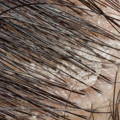A DANDRUFF & DRY SCALP BREAKDOWN

DON'T FREAK OVER FLAKES! A DANDRUFF & DRY SCALP BREAKDOWN
TO KEEP YOU COMFY & CLEAR
Let’s face it – flakes can be frustrating when you see them falling from your hair as you brush it or move around, but you shouldn’t feel alone. Dandruff is a common problem affecting up to 50% of adults worldwide.
Although it’s a common issue, discomfort, tightness, itching and flakes can be discouraging and inhibit your ability to feel fully confident in social settings or when wearing certain clothing that can make flakes seem more visible.
Looking to be flake-free? Read on to learn what causes dandruff and how to treat yours to keep flakes and discomfort at bay!
WHAT IS DANDRUFF?
Dandruff simply refers to the condition of the skin on the scalp that causes flaking; however, not all dandruff is the same. There are two types of dandruff, oily dandruff and dry dandruff, which are caused by different factors and are treated in different ways.
Dry Dandruff
Small, white flakes that fall frequently are easily loosened alongside sensations of itching, tightness and discomfort are characteristic of dry dandruff. The root cause of this condition is a dry scalp, which means that the skin is lacking moisture.
This can happen if your skin is already naturally prone to dryness, but it can also be triggered by external factors:
- Dry, cold weather
- Irritating or drying products used on the scalp
- Older age

Oily Dandruff
This type of dandruff differs from dry dandruff in that it appears as bigger, shinier flakes stuck to the scalp that are yellowish or whitish in color. Oily dandruff is primarily caused by a condition called seborrheic dermatitis, which occurs around the oil glands and causes the skin to be red, flaky and oily; however, oily dandruff can also be triggered by an overgrowth of the Malassezia fungus.
There are several external factors that can exacerbate symptoms of oily dandruff:

- Older age
- Stress
- Hormonal changes
- Nutritional deficiencies or underlying medical conditions
HOW TO TREAT IT
Since each type of dandruff occurs for different reasons, it’s important to choose the right course of action that suits your specific needs. Mild cases of dandruff or dry scalp can be typically treated at home, but if you experience persistent flakes after trying different remedies, it might be better to consult with a dermatologist.
1. Incorporate more moisturizing, oil-rich products.
For dry scalp, the main cause of dry dandruff is a lack of moisture. Using a gentle nourishing and moisturizing shampoo can help to restore hydration, making the likelihood of flakes and discomfort less. For oily dandruff, using oils can help regulate oil production, but it is worth noting that this should be done alongside other treatments. Coconut oil and tea tree oil have become more popular specifically in treating dandruff, due to their antifungal and antimicrobial properties.
2. Gently exfoliate the scalp.
Clearing away existing flakes on top of tackling a dry or oily scalp can help to minimize symptoms of dandruff, like itching and further flaking. You can do so with a chemical exfoliant such as a Salicylic Acid shampoo, or a manual one, like a scalp scrub or silicone scalp brush.
3. Avoid using hot water when washing the hair.
Hot water can exacerbate symptoms of a dry scalp, leading it to dry out further. To avoid potential irritation, wash your hair using lukewarm water.
4. Adjust your diet.
Just like other organs of our body, our skin does not function as well with a lack of proper nutrition. There are some ways to optimize your diet to enhance your overall scalp health:
- Increase your Omega-3 intake through foods like fatty fish, avocados, and nuts.
- Drink more water to prevent dehydration.
- Make sure you're eating enough protein and getting enough iron through animal or vegetarian sources.
- Incorporate more Zinc in your diet through foods like legumes, whole grains, meats, nuts, and seeds.

5. Use a targeted shampoo.
Whether you have dry dandruff or oily dandruff, special shampoos with targeted active ingredients can effectively ease symptoms. There are several main active ingredients commonly found in anti-dandruff shampoos for different reasons:
Salicylic Acid
This chemical exfoliant helps to slough away buildup and flakes caused by both Malassezia and skin shedding, which can alleviate symptoms like itching and irritation. By helping to speed up the resurfacing process, it may also aid in rebalancing the scalp. However, using Salicylic Acid too often can over-dry the scalp and cause further irritation, so it’s important to use shampoos with this ingredient in moderation.
Zinc Pyrithione
This ingredient is one of the most-used active agents in dandruff shampoos because of its ability to fight Malassezia and how well it is typically tolerated by the skin. Its antifungal properties are effective while remaining gentle enough for daily use.
Coal Tar
This agent is typically added in anti-dandruff shampoos for its ability to slow down the growth and shedding processes of skin cells, leading to less flaking. However, it can also stain lighter-colored hair and possibly irritate the scalp further, so it’s best to check with an expert if you’ve never used Coal Tar shampoo before.
Ketoconazole
This anti-fungal agent is available in prescription strengths and over-the-counter and helps to limit symptoms of more persistent and severe dandruff by targeting the Malassezia fungus to slow down its growth. It also has an effect on stimulating hair growth and can inadvertently help with those suffering from hair loss.
Selenium Sulfide
This ingredient acts on flaking and itching, thanks to its anti-inflammatory properties, and can be found in over-the-counter shampoos or in higher prescription-grade strengths. It’s a derivative of sulfur without the unpleasant smell, making it a popular option.
Some of our dandruff relief picks:
6. Consult with an expert.
If you’ve tried several methods to curb your discomfort and nothing seems to be working, it might be time to consult with a knowledgeable dermatologist who can prescribe a targeted regimen.





